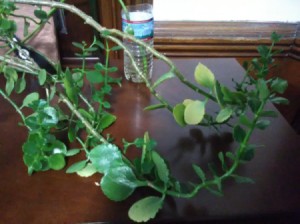
Pghgirl40
Bronze Feedback Medal for All Time! 196 Feedbacks June 28, 20180 found this helpful
It looks like a Kalanchoe Blossfeldiana. See link at the end of the message. I have been raising them for years.
Does yours get tiny orange or salmon color flowers? I have also seen red and yellow flowers.
These can be very prolific and get very leggy like the one in the photo. If you pinch them back and use the pinches to start new plants, you can have dozens by the end of the year. I root mine in mugs of dirt and transplant them into bigger pits when they get 6-8 inches tall.
They can get a little messy when the flowers drop, if you don't keep up with deadheading them.
They need watering every few days but not drowning, just kept moist. They like sun also, but are pretty forgiving and survive Pittsburgh seasons of gray!
goo.gl/.../wRrmDW
Enjoy! They are lovely plants!

July 2, 20180 found this helpful
I agree with Pghgirl40 and believe this is in the Kalanchoe family and the Kalanchoe Blossfeldiana is the one that seems to be the most popular variety.
- Your plant seems to be very "leggy" and would look more like the plants seen in most photos if you would prune off the long legs so it would grow in an upright position.
- You will also have to correct the problem that is causing it to grow so leggy.
- Insufficient light causes the plants to become leggy -- pruning them back can keep the plants from toppling over or suffering broken branches.
- Cut back overgrown or spindly stems as necessary to shape the plant, but avoid severe pruning. Maybe start with cutting back 1/2 of the leggy pieces and wait 2 or 3 weeks before pruning again.
- From one plant website:
- "Prune every stem back to just above the first set of healthy leaves proximal to roots, then eliminate any stems that spoil the symmetry of the stem arrangement. This is how you maximize the fullness/bushiness of your plant."
- www.hunker.com/.../how-to-cut-back-kalanchoe
- Here is an excellent site for care instructions.
- www.kalanchoe.nl/.../
- Plant care for blooms:
- "In order for Kalanchoe to bloom they need lengthy exposure to darkness similar to that of a poinsettia.
- Reduce light levels around Sept. 1 to promote winter flowering. Place the Kalanchoe plant in a cool, dark room from 6 p.m. to 8 a.m., allowing it no light during this period. Reduce watering and keep the temperature as close to 55F as possible."
- Continue for four to six weeks, and then resume normal care. Flowers will follow shortly.
- Repot Kalanchoe plants once per year in spring, after flowering. Move to a slightly larger pot each time."
Remember to keep this plant away from pets as it is reported to be poisonous and could make them sick if any part of the plant is eaten.
www.foundanimals.org/.../
 What kind of houseplant is this?
What kind of houseplant is this?